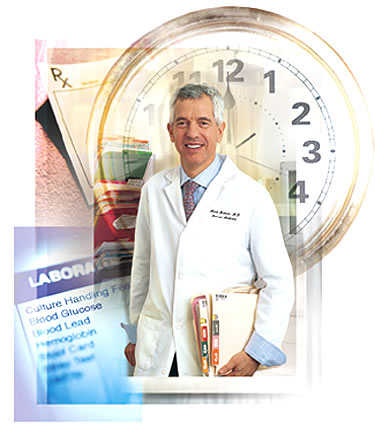Primary Care Pressure Cooker

![]() day
in the life of an academic primary care physician is typically harried:
test results to review, medications to order, phone calls to return,
and administrative and teaching responsibilities—not to mention
up to ten patients to see each hour. Here is a glimpse at a typical afternoon
for Mark Multach, M.D., chief, Division of General Medicine, and vice
chairman for clinical affairs:
day
in the life of an academic primary care physician is typically harried:
test results to review, medications to order, phone calls to return,
and administrative and teaching responsibilities—not to mention
up to ten patients to see each hour. Here is a glimpse at a typical afternoon
for Mark Multach, M.D., chief, Division of General Medicine, and vice
chairman for clinical affairs:
“Dr. Multach, it’s noon. You have patients at 1 p.m. and these messages: Dr. Tarkan wants you to call him about a patient—Mrs. Smith. Dr. Firder asked that you stop by for a minute to discuss the budget. Mr. Sarer needs prescriptions called in. Ms. Parker had her mammogram this morning and would like the results today.”
“Thank you, Jackie. Please send the messages by e-mail.” Hmmm … do I have time to stop to see Mrs. Smith on West Wing? Not if I want to be on time. I’ll go later.
12:30 p.m. “Good afternoon, Mrs. Glinson. Thanks for being early, I’ll be with you in a few minutes.”
“Nikki, please print out Mr. Sarer’s medication list. Also, can you call radiology, and ask the radiologist to page me sometime this afternoon with Ms. Parker’s mammogram results?”
“OK, Doctor. When you get a moment, I have a bunch of messages here for you.”
“Hi, Mrs. Glinson. How are you today? You look like you are feeling better since last week. What medication did you start? You don’t remember the name? I’m sorry, but I don’t have my office note from last week. Let me try to find the note. It’s not on this computer system. Let’s try this other one … great, it’s here. I’m not sure what it costs—let’s see if we can look online.”
Five minutes later … “Well, with your insurance it will cost $55 per month. Is that OK? No? OK, let’s look at the alternatives: This drug is less, but you will have to take it three times per day. Is that OK? Great—here’s a prescription. Let’s check your pressure on this new medicine in two to three weeks. Call me right away if there’s any problem.”
“Hi, Mrs. Fildo. What can I do for you today? Your labs? Let me check and see. No, not here on the chart. Not on the computer record. Not in our lab system. Where did you get the blood drawn? Let me ask Nikki if she can track it down. I’ll be back in a few minutes.”
“Dr. Multach, there is a call for you—a Dr. Prose from surgery. Can you see his patient for pre-op evaluation? At 5:30? OK, I’ll let him know.”
Twenty minutes later: “Mrs. Fildo, your blood pressure looks good today. Let’s go through your medicines. What are you taking now? Here are your prescription refills. You need a screening mammogram in April. Let’s schedule that on the computer. Do you mind if I answer this page? Thank you.”
1:30 p.m. “Hello this is Dr. Multach. Yes, I can see the patient at 5:30 after the other scheduled patients. No? Can she come another day? Please let me know.”
“I apologize for the interruption. Let’s write the order on the computer for your mammogram.” Several minutes pass by … “OK, that’s done. I will see you in three months..”
2:45 p.m. “I am sorry, Mrs. Seddy, I am running a little late. I’ll be back in a few minutes.”
“Thanks for waiting. How are you today?” Knock, knock. “Yes.”
“Doctor, can you fill this lab order out? They’re waiting for it. Thank you.”
4:45 p.m. “Mr. Slesil, I’m sorry for being so late. And I haven’t received the note or the test results from your visit to the specialist. Their office is closed. I’ll get the note in the morning and call you.”
OK, a few more calls to make on the drive home and notes to dictate. Let’s go see Mrs. Smith in West Wing.